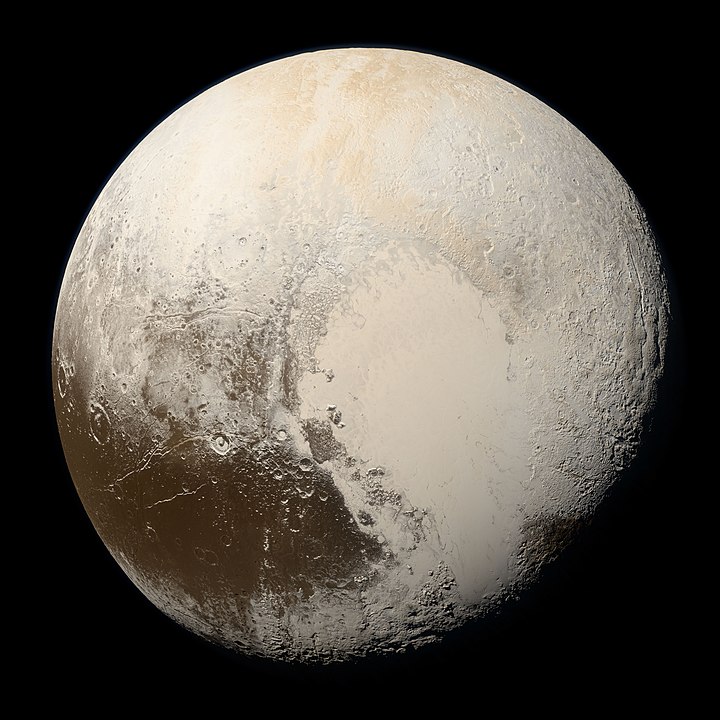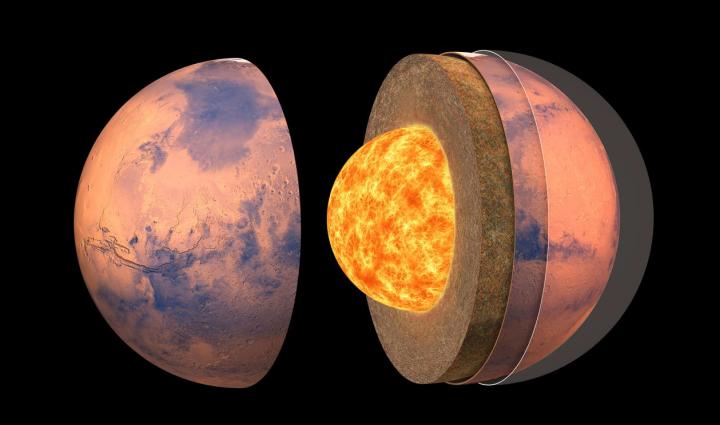Dr. Pamela and Beth each picked their three favorite stories from 2021, including news from Mars and Pluto and about distant comets and undead white dwarf stars. Plus, we interview Dr. Jackie Faherty from the American Museum of Natural History about citizen science, exoplanets, and JWST.
Podcast
Show Notes
Pluto’s past collision revealed internal structure
Lost: Mars Subsurface Lakes
- Arizona State University press release
- PSI press release
- “Strong MARSIS Radar Reflections from the Base of Martian South Polar Cap may be due to Conductive Ice or Minerals,” C. J. Bierson, S. Tulaczyk, S. W. Courville, and N. E. Putzig, 2021 June 28, Geophysical Research Letters
Undead white dwarfs skew age of star clusters
- ESA Hubble press release
- “Slowly cooling white dwarfs in M13 from stable hydrogen burning,” Jianxing Chen et al., 2021 September 6, Nature Astronomy
NASA’s InSight reveals inner Mars
- CNRS press release
- ETH Zürich press release
- IPGP press release
- University of Cologne press release
- NASA InSight Lander’s seismic observations reveal the interior of mars (EurekAlert)
- “Seismic detection of the martian core,” Simon C. Stähler et al., 2021 July 23, Science
- “Thickness and structure of the martian crust from InSight seismic data,” Brigitte Knapmeyer-Endrun et al., 2021 July 23, Science
- “Upper mantle structure of Mars from InSight seismic data,” Amir Khan et al., 2021 July 23, Science
Gamma-ray Burst Interrupted
- Gemini Observatory press release
- NASA press release
- NOIRLab press release
- “Discovery and confirmation of the shortest gamma ray burst from a collapsar,” Tomas Ahumada et al., to be published in Nature Astronomy (preprint on arxiv.org)
Massive comet creates an internet stir
- An enormous ‘mega comet’ is flying into our solar system (New Scientist)
- Extremely eccentric minor planet to visit inner solar system this decade (New Atlas)
- 2014 UN271: A possible dwarf planet from the Oort Cloud on a tour through the Solar System (MPLM Forum)
- Minor Planet Electronic Circular 2021-M53: 2014 UN271 (Minor Planet Center)
Overlooked Exoplanet Found by Citizen Scientists
- AMNH press release
- “A Wide Planetary Mass Companion Discovered through the Citizen Science Project Backyard Worlds: Planet 9,” Jacqueline K. Faherty et al., 2021 December 9, The Astrophysical Journal
Transcript
Hello and welcome to the Daily Space. I am your host Dr. Pamela Gay.
And I am your host Beth Johnson.
And we are here to put science in your brain.
Later on in the show, we will be joined by Dr. Jackie Faherty from the American Museum of Natural History to talk about citizen science, exoplanets, and her hopes for JWST. But first, let’s take a look back at some of our favorite stories from 2021.
This is our first show of a new year, and while every day has been blursday since early 2020, the time has actually been ticking forward, and with the new year, it is time to look back and see how our understanding of the universe has changed. In picking our top stories, we had a wealth of new missions – all the new craft at Mars, Lucy, DART. We had more exoplanets than we knew what to do with, and there were volcanoes, earthquakes, and climate change on our planet, while stars went flicker and flare across the universe, and dark matter was found missing in some places and clumped up in others.
Picking our top stories wasn’t just about picking the stories we thought would have the greatest impact over time. Some of these stories are just, well, our favorites. Let’s start with a look back at Pluto.

At last winter’s Lunar and Planetary Sciences Conference, doctoral researcher Adeen Denton presented a new analysis of New Horizons images that hint at Pluto having a 150-kilometer deep ocean beneath its icy crust. For comparison, the deepest point in the Earth’s ocean is the Challenger Deep in the Mariana Trench, which is just eleven kilometers deep.
These results are thanks to a new analysis of Pluto’s low-resolution side. During the New Horizons flyby, the mission got extremely good images on one side of Pluto and lower resolution images of Pluto’s other side while the mission was further away. There are a lot of tricks of the trade that allow folks to eke more information out of images, and over time, as our software gets better, we’re able to reprocess things and learn more. In reprocessing the low-res side of Pluto, they found a fascinatingly located region with a fascinatingly disrupted-looking terrain.
That location? Exactly opposite from Sputnik Planum, the smooth heart-shaped region imaged in such amazing detail. Many researchers have proposed that Sputnik Planum is actually an impact basin. If this is the case, when Pluto was hit by whatever it was hit by, the impact would have generated shockwaves that traveled through and around the planet. On other planets, we have seen a crater on one side and a disrupted terrain on the antipode – the opposite side – where the shock waves came together and tossed the land around.
Different kinds of land, planetary core material, and stuff in-between can all transport these waves in different ways. Denton ran what she calls a “small army” of Pluto simulations that each had oceans of different thickness and cores of either serpentine or other materials that don’t matter because it was a core of serpentine and an ocean 150 kilometers thick that produced the disruptions actually seen, we think, in the low-res images of Pluto. This gives Pluto a volume of liquid that isn’t too different from the volume occupied by life here on Earth.
Subsurface water, we’re learning, may be a norm for outer icy worlds, but in 2021, we learned that some of what we thought were subsurface lakes are actually something entirely different.

We talk a lot about water on Mars in the planetary science community. It’s an important topic. With plans underway to send humans to the red planet, scientists and engineers are concerned about how to provide the necessary resources for a prolonged mission. Water is heavy, and fuel is expensive, making it better for everyone involved if water is already on Mars, accessible, and relatively easy to make drinkable.
Last year, there were a lot of stories about water and ice on Mars it seemed, and there were quite a few trying to figure out just what was under Mars’ polar ice caps. Everyone was looking for subsurface water, and one study said they had found it there. That’s not the study that caught my attention, though. No, I was fascinated by a follow-up study that said the liquid lakes discovered with bright radar reflections were actually clays with metallic minerals in them.
These results do not rule out the possibility of liquid water, mind you. They just mean that we cannot always make a confident decision based on one possible analytic method if there are other methods available. Think of it this way: Just because you see the glint off a rock in the distance doesn’t mean you’ve found gold, so before you bring all your mining equipment over, you want to make sure you have found the right mineral.
This idea that not everything is as it seems kept cropping up, and from lakes that aren’t lakes, we now turn to white dwarf stars that aren’t entirely dead.

For about one hundred years, we’ve referred to white dwarfs as dead stars. These Moon-sized objects are the leftover cores of Sun-like stars that have run out of fuel for their core’s nuclear reactions.
But in 2021, researchers published Hubble observations showing that 70% of the white dwarfs in M13 appeared to be hotter than they should be, and this difference in temperature was consistent with the stars holding onto some residual hydrogen on their surfaces, where their extreme gravity allowed that hydrogen to undergo nuclear burning and thus heat up the star.
White dwarfs were — were — thought to form at a specific temperature and spend the rest of eternity slowly cooling in ways that can be understood thanks to standard thermodynamics. If some fraction of white dwarfs aren’t completely dead but are instead only mostly dead and are actually burning some hydrogen on the surface, then those cooling rates don’t work. And when we try and calculate their age, they will appear to be far hotter — and thus younger — than they would be without that burning.
This is a new frustration for astronomers. There are literally undead white dwarfs out there mucking up their age estimations.
From zombie stars, let’s now turn to what turns out to be a living planet and look at marsquakes.

I have to admit, when 2021 started, I thought we would be spending tons and tons of time discussing NASA’s Perseverance rover and its little helicopter, Ingenuity. After all, NASA sent out press release after press release prior to launch and prior to landing. And, well, we did talk a lot about Percy. But it wasn’t that rover that caught my attention and quickly became my favorite Mars mission. No, that distinction is given to NASA’s InSight lander, or as I like to call it, the Little Lander That Could.
InSight struggled a bit at the beginning. The probe that was supposed to go deep under the surface never made it. Dust was coating the instruments and the solar panels. And yet, InSight’s team never gave up. They found ways to work on the problems and even solve them, mostly using the scoop on InSight, and we have all said now that every Mars mission should have a scoop. While the probe never did get far enough into the soil, the team did manage to insulate the seismometer and partially clear the solar panels of dust.
And that seismometer had an amazing year, detecting hundreds of marsquakes. Scientists from multiple research teams then used the information from those quakes to work out just what makes up the inside of the red planet. They found a crust that is between 15 and 47 kilometers thick (relatively thin by Earth standards), a mantle under that crust that is similar in composition to Earth’s mantle but with more iron, and a core with a radius of 1,840 kilometers – 200 kilometers larger than hypothesized fifteen years ago. That core contains more light elements like sulfur, oxygen, carbon, and nitrogen than Earth’s core, but it is still liquid, which is a bit surprising given that Mars doesn’t have a magnetic field anymore.
I am definitely looking forward to seeing what 2022 brings for this mission and expect great things and even more marsquakes.
A lot of astronomy and planetary science is focused on catching these transitory events, and using them to probe the realities of objects that otherwise may never seem to change. And not all transitory events are as calm as these small quakes.

Back in 2020, a long gamma-ray burst attempted to masquerade as a short gamma-ray burst; for just 0.65 seconds, the Fermi Gamma-ray Space Telescope detected something. The Zwicky Transient Facility went on to observe a supernova explosion in the same part of the sky, and it’s now thought that this was a classic long-duration gamma-ray burst that for some reason had an abbreviated duration.
It is believed that when some massive stars end their lives as supernovae, something happens that causes powerful jets to form, and those jets funnel gamma rays and other radiation in a narrow cone. When one of those cones happens to be directed at us, we get to see a long gamma-ray burst lasting up to hundreds of seconds in duration.
Hundreds of seconds is longer than the 0.65 seconds seen here.
The researchers behind this paper believe that the conditions in this event were just at the border of what is necessary to form a gamma-ray burst, and what we saw was the system teetering out of the zone that would allow a normal, long-duration burst. This makes it clear that while all long-duration gamma-ray bursts are tied to supernovae, not all supernovae can support or sustain a gamma-ray burst. At a certain level, we knew that from statistics — there are too few gamma-ray bursts for their scarcity to be explained just by how often we are or aren’t in the cone of their jets. Now we have seen that transition case, where something tries really hard to be a gamma-ray burst and just doesn’t quite make it.
You do you, Lil gamma-ray burst. We understand that sometimes we don’t all get to scream into the void of the universe for as long as we’d like, and we respect your efforts.
And sometimes, it’s the scientists that want to scream into the void of the universe when the press releases get interpreted in the wildest possible ways, as is the case with our next story.

In my final favorite story of 2021, a trans-Neptunian object was found and confirmed using data from the Dark Energy Survey. The object, called C/2014 UN271 (Bernardinelli-Bernstein), was captured in data from 2014, 2016 and 2018, and is a large comet, somewhere between 100 and 370 kilometers in diameter. Its orbit is about 600,000 years, with the furthest distance at 0.6 light-years, and incredibly eccentric or elliptical. And at the end of this decade, it will make its way almost to Saturn’s orbit.
Of course, that’s only part of what made the story so interesting. The big thing was that so, so many headlines were shouting that a giant comet was heading toward Earth! Well, yes, in a manner of speaking, sure. The comet is headed vaguely in the direction of Earth’s orbit as things that are in highly elliptical orbits tend to do as they approach the Sun. But this comet will get nowhere near Earth’s orbit, let alone near Earth.
And so I had a bit of a rant about misleading headlines and clickbait. Don’t fall for them, everyone. As we go into 2022, remember to take sensational headlines with a large grain of salt. If you have questions about a story you saw somewhere, please ask Dr. Pamela or me what the facts are because a lot of news sites are out to get eyeballs, and they never seem to talk about asteroids and comets when they’re not able to call them a potential threat.
Discoveries don’t just come from big surveys with hundreds of scientists. Sometimes, they come from citizen science projects.
Interview
One final story to look back at from last year was the discovery of an exoplanet by citizen scientists in the Backyard Worlds: Planet 9 project. The new world is either a massive gas giant or a brown dwarf, and it is an astonishing 1,600 AU from its parent star. That distance kept the planet from being found during previous exoplanet campaigns, but there it was, just sitting there in the data, waiting to be found. And it was citizen scientists who found it.
Joining us now is Dr. Jackie Faherty, senior scientist in the Department of Astrophysics at the American Museum of Natural History and the co-founder of the Backyard Worlds: Planet 9 project and lead author on the resulting paper from the discovery.
Thank you for being here today, Dr. Faherty.
[Transcript unavailable.]
This has been the Daily Space.
You can find more information on all our stories, including images, at DailySpace.org. As always, we’re here thanks to the donations of people like you. If you like our content, please consider joining our Patreon at Patreon.com/CosmoQuestX.
Credits
Written by Pamela Gay and Beth Johnson
Hosted by Pamela Gay and Beth Johnson
Audio and Video Editing by Ally Pelphrey
Content Editing by Beth Johnson
Intro and Outro music by Kevin MacLeod, https://incompetech.com/music/


 We record most shows live, on Twitch. Follow us today to get alerts when we go live.
We record most shows live, on Twitch. Follow us today to get alerts when we go live.